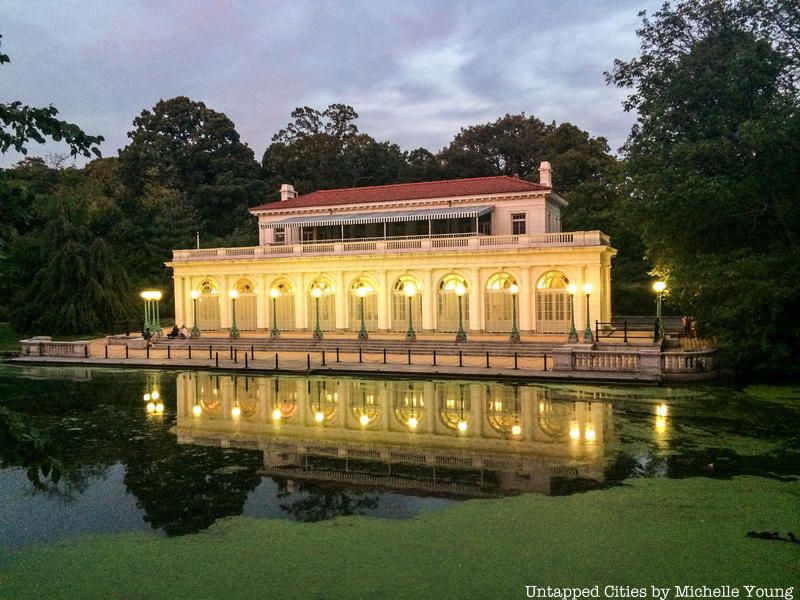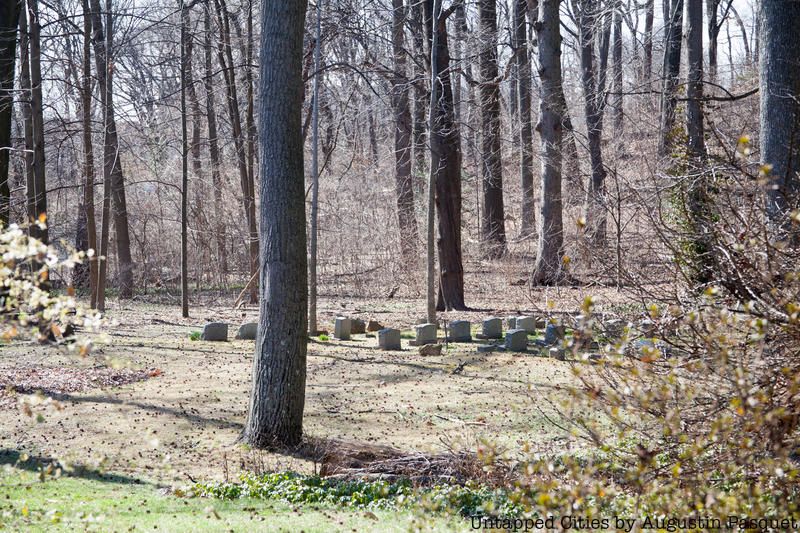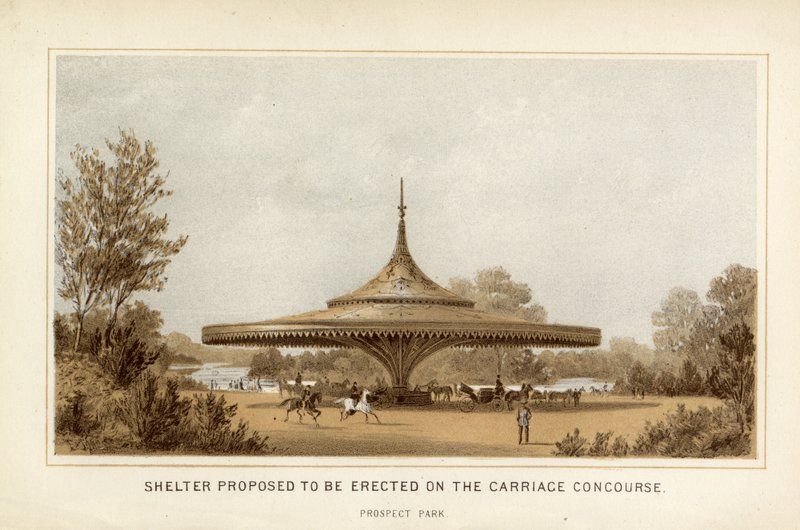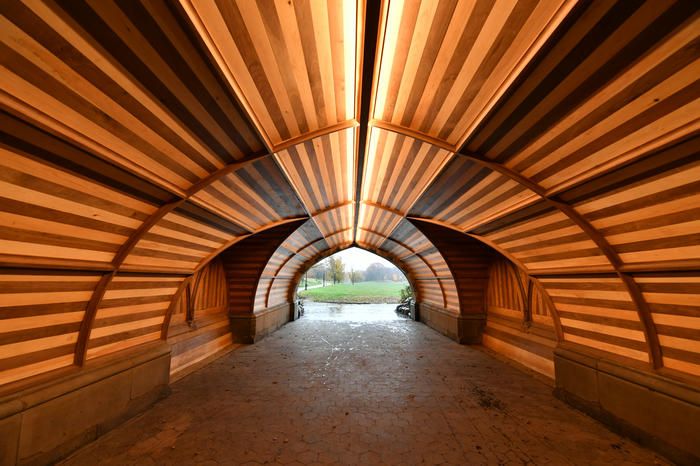Last Chance to Catch NYC's Holiday Notalgia Train
We met the voices of the NYC subway on our nostalgia ride this weekend!



Prospect Park is one of the most beloved of New York City’s parks, rivaling Central Park in splendor. Indeed, Prospect Park is often seen as the park where designers Frederick Law Olmsted and Calvert Vaux perfected their art, having learned from their mistakes in Manhattan. The park officially opened in 1867, though construction continued for years after, spanning an entire three decades from 1865 to 1895. Within Prospect Park’s 526 acres, you will find a zoo, the first urban-area Audubon Center in the nation, an ice rink, a band shell, a carousel, and athletic and recreational facilities scattered throughout Olmsted and Vaux’s naturalistic design of intricate manmade wetlands, indigenous forest, and rolling green meadows. You will also find an abundance of secrets waiting to be revealed. Here we explore the top ten secrets of Prospect Park, from hidden cemeteries and never-built structures to remnants of the Revolutionary War.

Off Center Drive, there are 2,000 gravestones and buried bodies, many older than the park itself. This property, the only private property in the park, is a cemetery owned by the Religious Society of Friends, more commonly known as Quakers. Established in 1849, though it is believed there are graves that date to the 1820s, the 10-acre Quaker cemetery remains active to this day.
In the original plan for the park by civil engineer Egbert Viele, which would have made the park about 55% smaller, the cemetery wasn’t within the bounds of the park. It is easy to miss as it is in a fenced-off area of woods and the stones are small and simple. Buried inside are a few famous Quakers such as Raymond Ingersoll, a former Brooklyn Borough President, and actor Montgomery Clift.

At the deadly Battle of Brooklyn (or the Battle of Long Island), the Maryland Regiment led by Major Mordecai Gist, only 400 strong, held out against 2,000 Scottish and Hessians in what is now Park Slope around the Old Stone House. Though the Americans were eventually forced into a panicked retreat across Long Meadow, it allowed George Washington’s Army to cross the East River into Manhattan. When Prospect Park was built, the remains of many soldiers left behind as well as fortifications and pits from the Revolutionary War were discovered.
At the base of Lookout Hill, a Stanford White-designed monument was erected to commemorate the heroic stand of “The Maryland 400.” It was dedicated on the 119th anniversary of the battle in 1895. The Maryland Monument is made up of a 12-foot tall polished granite column topped with a marble orb. It is similar in form to White’s Prison Ship Martyrs Monument in Fort Greene Park. The wrought iron fence was added later.
In addition to the Maryland Monument, there are more spots in the park where traces of the Revolution can be found, from the Donogan Oak Monument (a monument to a felled tree used to block a path into the park) to the Battle Pass Rock which marks one of the former points of entry along the American defense line. Battle Pass was also near the site of the now-lost Valley Grove Tavern run by Hicks Post who affectionately called it his “little snuggery.” It was a popular stop for those en route to Coney Island.
Even the centuries-old trees may hold within them remnants of the Revolution. There has been talk of x-raying the trees in Nethermead to see if there are Revolutionary War bullets embedded inside. Another route with deep history which runs through the park is the path of East Drive which partially follows an old Native American trail which according to Prospect Park: Olmsted and Vaux’s Brooklyn Masterpiece, “branched off a larger path that ran between what is now Atlantic and Flatbush Avenues.”

Olmsted was one of those quintessential creative, explorer types. Turning down admission to Yale, he wandered around the countryside, traveling like a modern-day backpacker. He signed up as a seaman aboard a ship going to China and lived as a farmer for seven years in Connecticut. It was this combination of experiences, particularly the latter, which gave him a keen understanding of the importance of drainage systems in parks.
The system Olmsted designed for Prospect Park was ahead of its time. It used runoff to refill the bodies of water throughout the park rather than adding that water into the municipal sewer system, which was frequently overrun as is. Prospect Park: Olmsted and Vaux’s Brooklyn Masterpiece deems the system “an invisible web” of clay drainpipes that run the length of Long Meadow, connected by smaller pipes and a series of “vaulted retention basins.” Separately, it is said that a tunnel once ran from below the Park Slope Armory into Prospect Park. Inside the armory, a bricked-off entrance to this tunnel is visible. You can feel a breeze from the removed bricks on top of the entranceway. It is believed that large portions of the tunnel collapsed due to the construction of the subway and residential expansion in Park Slope.

In 1932, Robert Moses had a replica of Mount Vernon built in Prospect Park to mark the 200th anniversary of George Washington’s birth. The building was constructed by Sears, Roebuck & Company (who also delivered another replica to the Exposition Coloniale Internationale in Paris in 1931, which still stands as a private home). The Brooklyn replica was designed by architect Charles K. Bryant.
The structure only stood for a mere two years before being torn down. It was one of the shortest-lived buildings in New York City. The house was located at the base of Lookout Hill on the Peninsula of the Lake.

The panic of 1873, a financial crisis that lasted for a few years, caused a scaling down of plans for Prospect Park. Only ongoing projects were allowed to be completed. This meant that structures designed by Calvert Vaux, like a restaurant to be called the Refectory, an observation tower modeled after Venice’s Piazza St. Marco bell tower, and a carriage concourse were never completed.
The Carriage Concourse was intended to have a 100-foot canopy that would offer shade for horses and carriages. A shelter next to the concourse also remained unbuilt. Though a handful of structures were left on the drawing board, there were also buildings constructed that are now gone from the park, such as a dairy and a menagerie. You can see 10 of these never-built structures in a previous article produced in partnership with Prospect Park Alliance.

In the summer of 2018, Prospect Park added a new member to its Natural Resources Crew, a giant orange boat dubbed originally the Lake “Mess” Monster. The aquatic weed harvester travels along the lake getting rid of excessive weeds that are later disposed of as mulch. Getting rid of these weeds helps keep the lake from being overrun with aquatic pests such as floating water primrose and duckweed. The bright new piece of equipment replaced an older model which was used in the park for twenty years.
A public vote was held on what to name the new contraption, as Lake “Mess” Monster was just temporary. More than 300 entries were submitted and then narrowed down and voted on by the park community. Out of the final nine options, the winner by a margin of 30 votes was “The Floating Goat.”

There are many historic homes in the borough of Brooklyn and one of the oldest can be found right inside the park. The Lefferts Homestead, located at 452 Flatbush Ave, was originally built in the farming village of Flatbush. Today, the quaint Dutch-style home sits in Prospect Park, six blocks from its original location. Built in 1783 after a previous structure was burnt down by American soldiers in the Revolution, the building was home to the Lefferts family, one of the wealthiest and most influential families in Brooklyn at the time.
In order to save the home from threats of new development, John Leffert’s estate offered it to the city of New York in 1917 with the promise that it be moved onto city-owned property. The relocation ensured the home would be preserved for generations to come. The home now operates at the Lefferts Historic House museum where visitors can try their hand at 18th-century activities like candle making and butter churning while exploring the beautiful gardens and historic artifacts inside the house. The home reopened in May 2023 after a $2.5 million renovation.

Inside the Wellhouse Comfort Station, the last remaining building in Prospect Park constructed by park designers Frederick Law Olmsted and Calvert Vaux, you will find the first composting bathroom in a New York City public park. Similar composting systems are in place at the Bronx Zoo and Queens Botanical Garden. The toilets in the innovative composting system designed by Swedish company Clivis Multrum use 97% less water than a traditional toilet, saving 250,000 gallons of water per year. Water from the sinks, floor drains, and janitor sinks in the comfort station will go into the greywater garden.
The Wellhouse Comfort Station dates back to 1869 when it originally contained the coal-powered steam engine mechanical pumping system that fed the streams and manmade features of Prospect Park. It was rendered obsolete when Prospect Park was connected to the city’s water system and the building fell into disrepair. Along with the addition of the composting system, the building underwent a major restoration. The portico was recreated, a historic paint scheme was applied, a new roof was installed and a significant below-ground excavation was carried out to make room for the new composting bins.

The Endale Arch was one of the first architectural features erected in the park in the 1860s. In 2020, a $500,000 five-year restoration project was completed which restored and revealed original features of Olmsted and Vaux’s design. The arch serves as an entryway to Prospect Park’s Long Meadow from Grand Army Plaza. It is meant to act as a portal, transporting visitors from the urban bustle of Brooklyn to the natural tranquility of the park.
Pieces of New Jersey brownstone and yellow Berea stone created a polychromatic masonry pattern on the arch’s exterior. Inside, the tunnel was paneled with alternating rows of white pine and black walnut wood. Benches were tucked into vaulted niches, offering parkgoers a cozy place to rest. Over the decades, interior details were painted over with green anti-graffiti paint, water damage caused much of the original wood to rot away, and the weather took its toll on the exterior. Restoration work started in 2015 to stabilize the arch, replace rotted wood was replaced, and add lighting. Now, as you walk the arch, it is how the designers intended.

“Wildman” Steve Brill leads foraging tours of New York area parks, including Prospect Park. Technically foraging is illegal in the city parks, and in the 1980s, Brill was arrested by NY Parks Rangers for eating a dandelion. The arrest only served to enliven Brill’s foraging career and he eventually became an official Parks Department naturalist. For many years now, he has run tours independently and with his daughter.
Brill’s tours are part of his mission to promote urban agriculture and sustainable eating. He has published three books on wild eating, consulted for the Parks Department, and advised several New York chefs on sustainable ingredient choices. You can learn more about Brill and his tours in Secret Brooklyn.
Next, check out Top 10 Secrets of Central Park and 5 NYC Parks Bigger Than Central Park
This article was written by Michelle Young and Nicole Saraniero
Subscribe to our newsletter